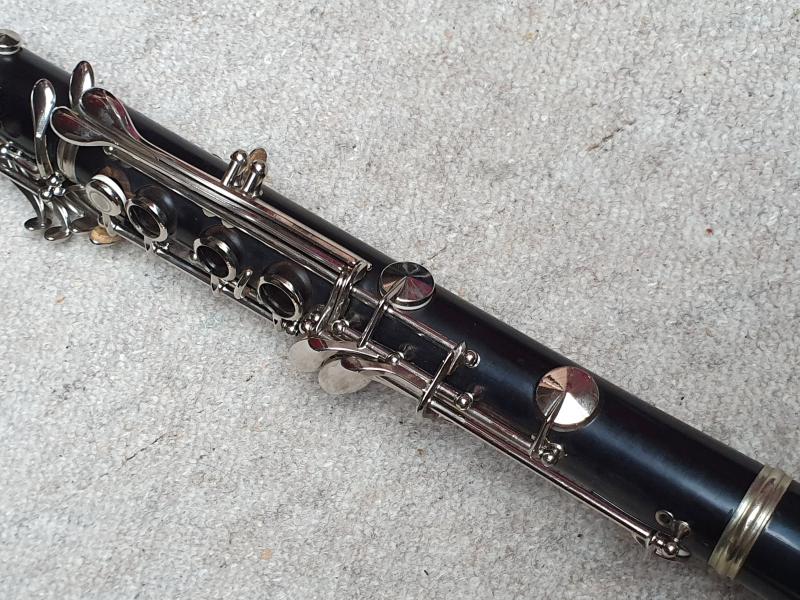

- #Amati kraslice clarinet serial number serial numbers#
- #Amati kraslice clarinet serial number full#
- #Amati kraslice clarinet serial number pro#
- #Amati kraslice clarinet serial number series#
I wonder if they sent these parts out for assembly by trusted, experienced craftsmen.
#Amati kraslice clarinet serial number series#
In some cases, a horn has the mass-produced valve block and serial, but with a second number stamped around the receiver, fitting in the Meister series - my "semi-pro" Arioso Super is one of a few like this.

#Amati kraslice clarinet serial number pro#
The Meister series usually has 2-piece valve casings, a model name indicating an attempt at a pro design, and a small number stamped parallel to the bottom cap of the 2nd valve casing, left-hand side, near the cap.

The first is recognizable by the large numbers stamped on the left-hand side of the 2nd valve casing, perpendicular to the cap.
#Amati kraslice clarinet serial number serial numbers#
The serial numbers appear in two major sequences: I call the first the "mass-produced" series, and the second "Meister series". The Soviets didn't see a problem with that, and Amati instruments probably have half their issues due to the materials used. I recall Elmar mentioned the "brass" used contained more impurities than Western brass, since it had been recycled from Soviet artillery shell casings containing high amounts of lead, primed with mercury. While musical instrument manufacturing was prioritized, Amati quality still suffered under the command economy.

I thin they began churning out their infamous designs by the end of that plan. This was a continuation of the earlier model, just under state control. That said, the state managers knew that musical instrument export was a great way to get much-needed hard currency, and they could build upon the network of small craftsmen building from parts milled out in the central shop as "showpiece" horns, called "Meister Trompete" in a 1970s-80s catalog. Meanwhile, Czechoslovakia was re-industrializing under a Five-Year Plan, on the Soviet model. I don't know how Karl Fuchs of B&F fared, since the B&F name appears on Amati horns into the 1980s, and Fuchs died in Germany in the 1960s. Hüttl was also awarded compensation for what Amati had seized in 1945-6. In 1955, the European Court in The Hague ruled in favor of Keilwerth. Keilwerth argued that their family owned these trademarks, but Amati countered in stating they were the "legal" corporate successors, who inherited the rights to the name. Pigtail crook peashooter trumpets, rimless "Vocabell" peashooters, octagonal bell trumpets, all sorts of others.Īmati kept using its constituent firms' trademarks, and in the case of Keilwerth, continued making saxophones in the same sequence with no changes. In other cases, the Amati name appears on a wide range of prewar designs, likely just finished instruments made with leftover parts. He would have had connections to all of the former German suppliers and to new firms run by his former workers, and could easily have subcontracted work there - particularly in East Germany", explaining the occasional Amati trumpet with Made in Germany on the top of the receiver, in the manner of really early Böhm-Meinl trumpets, as well as a distinctive type of valve block used early on. Keilwerth family members were retained to assist with operation - "Max was retained by Amati to consult on the integration of the cooperative. This interesting bit was in a HUC thread until it disappeared, wit this summary on the Amati page.
#Amati kraslice clarinet serial number full#
Hüttl, Franz Michl and Kohlerts Söhne" - some of these trademarks will be used alongside the Amati name for several yearsġ948 - Communists take full control of Czechoslovakia, nationalizing industries and continuing consolidation, which was complete by 1952 The co-op also consists of "a total of 322 producing musical instruments.Josef Glassl, Bohland & Fuchs, Julius Keilwerth, A. OctoAmati cooperative of musical instrument manufacturing is established, with representatives meeting in the cafeteria of the F. It doesn't help that there are a few sequences in use that often overlap. Unfortunately the photos I saved sometimes went missing, and the early horns are a hodgepodge of parts and suppliers. There isn't much in the way of English-language material, but Brasspedia details the founding of Amati-Kraslice pretty well. While they still exist, they don't have much in the way of records when I inquire about past models, and they've mentioned their serial "list" is vague before the 1980s, when they implemented computer record keeping. I hate to admit that I own more of these than I should, partly due to my fascination with their designs inspired by Conn, ranging from simple aesthetics like the "grip rings" on the valve casings, to the design of pistons similar to the barrel-spring type in Victors and Connstellations. I'll have to go back through later, but this is a start. This is my attempt at piecing together a chronology of Europe's infamous band instrument manufacturer.


 0 kommentar(er)
0 kommentar(er)
